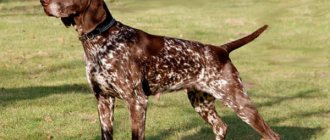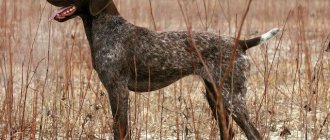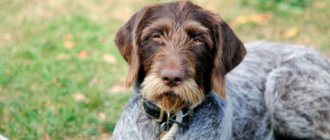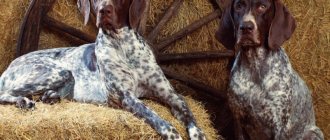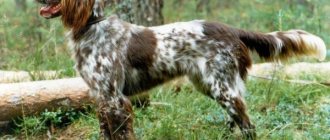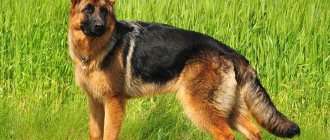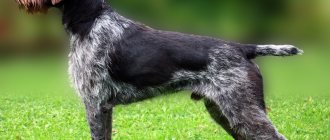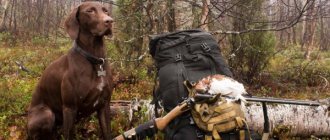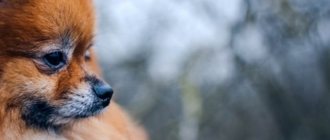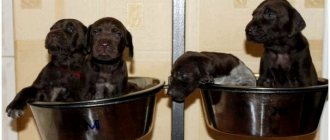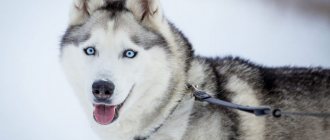Every person who is fond of hunting dreams of getting the ideal dog as a partner. If he hunts birds or small animals, he will want to get a gun dog. Continental Pointers are considered versatile hunting dogs, they are so popular that professionals still argue about who is better - the Drahthaar or the Shorthaired Pointer.
Drathaar- Kurzhaar
Both breeds have excellent top and bottom senses. They are indispensable companions if you hunt with a stand for different types of game. Both drats and chickens are excellent swimmers; they willingly climb into the water to reach a shot wild duck. If a representative of this breed is under the gun, then hunting for small animals will not disappoint.
Character of the shorthaired pointer
The shorthaired pointer stands out among other hunting dogs. The thing is that Shorthaired Pointers can do everything: hold a perfect stance, follow the scent and bring prey, and besides, they are excellent guards. It is difficult to find a more hardworking and patient companion.
In ordinary life, these dogs are excellent athletes. They are very energetic and cannot sit idle. If you do not give an outlet to their energy and do not direct it in a peaceful direction, the dog may begin to look for activities on its own. It is possible that she will decide that the idea of methodically gnawing furniture is not so bad.
The shorthaired pointer has a strong character. This dog is prone to dominance and will defend its rights to a place in the family hierarchy. It is important that the owner is ready to give a timely rebuff and knows how to show who is boss in the house. Otherwise, the dog will take the lead, and then it will be very difficult to force it to obey.
Dogs of this breed recognize only one owner. With it they are ready to go for a morning jog, hunting, or to the ends of the world. Emotional contact and communication with a person is very important for them. These dogs cannot be left alone for a long time - they tolerate it very hard.
But at the same time, this breed is not suitable for families with small children - the Shorthaired Pointer finds contact with adults much easier and faster than with children. However, this does not mean that the dog can be aggressive, not at all: rather, it can be excessively active, which will frighten children.
Dogs of this breed get along well with other animals, especially if they grew up together. But don't forget about hunting instincts. In this breed they are very strong, and small pets automatically turn into potential hunting targets for the shorthaired pointer.
When it comes to communication, the shorthaired pointer is one of the loudest dog breeds. Shorthaired pointers bark a lot and with pleasure. To the point and just like that. Therefore, the owner’s primary task is to start raising the animal as early as possible. With the right approach, these dogs clearly understand the rules of behavior, and then you can get them to significantly reduce the level of noise they produce.
Dogs of this breed are extremely intelligent. They are easy to train and seem to enjoy the activities. It is rare to hear that a shorthaired pointer is impatient or stubbornly refuses to carry out some task of its owner.
Pros and cons of the breed
Of course, before you get a Drahthaar hunting dog, it will be useful to study the main advantages and disadvantages of this breed.
In general, this is a universal breed - the Drathaar dog can become an excellent assistant in hunting and at home. They are often used as defenders and security guards - their intelligence and size make it quite possible to cope with such tasks.
By the way, this is more of a guard than a defender. He will defend his usual territory - from an apartment to the courtyard of a private house - to the last drop of blood, but when leaving it, he no longer feels so confident, so the dog can become a good bodyguard only through special training.
Discipline in parenting is very important
In most cases, they perceive the dogs around them very peacefully and do not get into fights, although they cannot be called cowardly.
However, a certain independence is inherent in it - when hunting a large animal you cannot do without it. Therefore, you should not expect that the drathaar will perfectly and unquestioningly carry out all commands, like, for example, shepherd dogs.
In addition, like many hunting dogs, the Drathaar perceives all small animals exclusively as prey. You should not have them in an apartment where cats, rabbits or other pets live - the life of the latter will become simply unbearable.
Education and training
Do not start training the Shorthaired Pointer from an early age. Let him get used to things and surroundings. Introduce your puppy to other animals in the house and people. He will establish emotional contact with them in order to become a balanced dog in the future. But you need to teach your puppy to sleep and eat at certain times from a very early age. At first, take the puppy outside immediately after feeding and sleeping. If this is not possible, then put it on a diaper. This will teach your dog to go outside to the toilet.
At 2.5 months, begin to accustom your pet to training. Start training with simple commands and gradually move on to more complex ones. Representatives of this breed have a specific feature: they can forget what they have previously studied. Therefore, combine repetition of previously covered and new material.
The strong character of shorthaired pointers also manifests itself during training. Show leadership qualities in a timely manner, otherwise your pet will not follow commands. Severely stop attempts to attack other animals even in the game. Kurzhaars are curious and tend to get distracted from the learning process. Make sure there are no bright smells or toys nearby.
Diversify your training, break up monotonous commands with logic games. Add something new every day, don't stick to one workout plan. To develop a hunting sense of smell, bury pieces of meat in the ground and invite the dog to look for them.
Bitches are easier to train, males are more willful and require a strong hand. Don't let your children go for a walk with the dog alone. She may feel a weak hand and then it will be difficult to train her again.
A puppy can be taught to hunt from the age of 6 months and begin walking in the forest. By this time, the dog should be well socialized: understand the owner well; know the street and other animals; do not be afraid of loud and unexpected sounds, cars and people. It is best to develop hunting skills in the morning; at this time, the dog’s hunting instincts are strongest. Start with brisk walking. Your pet should get used to following you and keeping up. Hide a bird carcass in advance to teach your dog to pick up a scent. Keep a few feathers for yourself, give your dog a sniff, and send him off to look for prey. After your pet learns to find game, teach it the “fetch” command. Always praise your dog for successful completion. The first hunt should take place at approximately 9 months.
If you do not plan to go hunting with your dog, then it will need additional exercise. Train your pet on obstacle courses and play frisbee with him. Encourage your pet only if he has followed the command correctly, otherwise you risk spoiling the dog.
Let us briefly formulate the basic rules of training:
- start with simple workouts and move on to more complex ones;
- repeat completed workouts;
- create a varied training plan for every day;
- do not give in to the dog, she should know well what she is not allowed to do;
- reward only for correct execution of commands;
- do not physically punish the dog or deceive it;
- repeat training, do not take long breaks.
Character and hunting qualities
As mentioned above, the Drachterrier (they are sometimes called that) can become an excellent family pet and guard. But it is worth remembering that, first of all, he is a born hunter. This is important to consider so as not to be disappointed in the breed later.
Innate qualities
For many decades, experts bred an excellent hunting breed, and then for more than a century they consolidated the selected qualities. Therefore, a dog cannot be called particularly affectionate.
It is much more pleasant for them to run through the forest for hours than to bathe in luxury or play with their owners. So, first of all, the Drathaar is a dog for hunters. They are not very fond of strangers and are suspicious of them, which makes drathaars good watchdogs.
In the natural environment, that is, while hunting with the owner
Another feature that is not typical for hunting dogs in general is the desire for dominance. It is very important to show the dog who is in charge in this union. Otherwise, the dog will really sit on the neck - refuse to follow commands, will not obey, and may well respond to aggression symmetrically. So, you always need to keep your eyes open with them - be a strict owner, but at the same time be able to manipulate the pet.
Important! The amount of feeding the dog depends on its mobility. Those who go hunting several times a week should eat much more than their relatives who rarely leave the apartment.
Attitude towards children and others
As mentioned above, he doesn’t like the dogs around him too much, and sees small animals exclusively as prey.
Relationships with children are difficult. On the one hand, the drathaar is unlikely to show unjustified aggression towards them. On the other hand, he will not allow the child to pull his ears, pull his tail or pull out his fur. Therefore, he obviously will not become a particularly good partner for children.
It is noteworthy that children generally have difficulty pronouncing the unusual German name. In their stories and writings, the father's hunting dog is presented as darkhar, dorkhan, draghound, drag hard, etc.
Maintenance and care
Shorthaired Pointer wool has water-repellent properties and does not stick to furniture and clothing. But at the same time, shorthaired pointers shed very intensively, so they should be combed regularly, but bathed only as needed. The shorthaired pointer's coat is short, so you don't have to take the dog to the groomer; home care will suffice. To comb out, use a stiff natural bristle brush or a special mitten.
Special attention should be paid to the ears: they should be cleaned regularly and ensure that they are dry. To prevent your dog from getting infectious diseases, wipe his ears with cotton pads every day. If necessary, use cotton swabs and ear cleaning solution from a pet store.
It is enough to wipe the dog’s eyes with a cotton pad soaked in strong tea leaves. If your pet's eyes begin to water or produce pus, contact your veterinarian.
If the dog is sufficiently active, he will not need additional nail care. It will wear them down naturally. But if the nails become long, trim them. Treat the claws additionally with a nail file if you are using a mechanical nail clipper. Wipe the paw pads periodically with vegetable oil.
To keep your pet's teeth healthy for as long as possible, perform hygienic brushing twice a week. There are brushes and pastes for dog teeth.
Hurry up, choose a box and find out what gift awaits you
Discount on pet insurance
Promo code copied to clipboard
You need to walk a shorthaired pointer a lot and in a variety of ways. Dogs of this breed will happily run, swim, play - in a word, they will support any activity that the owner comes up with for them. Lack of physical activity can cause excess weight and, importantly, provoke aggressive behavior in the animal.
At home, your dog should have its own warm corner without drafts and with plenty of toys. This breed is not suitable for being kept outdoors in cold regions. The Shorthaired Pointer has short hair and no thick undercoat. Dogs of this breed can live outdoors at temperatures down to -7°C. But at the same time, they still need an insulated enclosure without drafts.
Description of the German Dreadhar breed
Of course, before getting a dog like the Drathaar, it will be useful to study the description of the breed. Then you won’t have to regret the poorly chosen pet later.
Breed standard
In general, dogs of the Drathaar breed are quite large - at the withers, females reach 57-64 cm, and males are even larger, about 61-68 cm. However, they cannot be called particularly heavy - according to their characteristics, the average weight is 23-32 kg.
The ears are long, hanging freely, but at the same time wide, set high. In most cases they are not stopped.
The tail is short, barely reaching mid-thigh. If necessary, it can be docked in childhood to prevent the drathaar from being injured while hunting.
Popular colors of drathaars
Dog on the hunt The coat is very hard and of medium length. There are several color options:
- brown,
- black with gray hair,
- gray-haired
Brown dogs may also have a white patch or gray spots on their chest.
Sometimes completely black drathaars are found, but here only an expert will be able to say whether a particular specimen meets the requirements of the breed or is a defect. And the opinion will be very subjective.
For reference! Inexperienced dog lovers often call the breed incorrectly, and in very different ways: dreadhard dog, drat hart, dart hard, dredd har, etc.
Nutrition
Your dog should always have access to clean drinking water. Up to six months, puppies are fed 5 times a day in small portions. After six months, you can switch to two meals a day.
We recommend feeding the Shorthaired Pointer only commercial food. It does not contain flavor enhancers, preservatives or other additives harmful to dogs that can be found in human food. Combine wet and dry food. Wet food contains the water your dog needs, while dry food cares for the digestive system. The diet of an adult shorthaired pointer should contain protein in large quantities; choose premium food. Food should nourish the dog, allow it to remain strong and resilient, so cheap food is not suitable. Calorie content depends on the age of the dog. For young shorthaired pointers, choose diets with a high calorie content, for older dogs - less nutritious. If your pet has health problems, then the food should be selected by a veterinarian. There is a special therapeutic diet for this.
What to look for when choosing food:
- Compound. Meat should come first. The percentage of components in the composition decreases from beginning to end.
- Carbohydrates. Choose rice or buckwheat instead of wheat or corn, then your dog will not have problems with food intolerances. Cereals are contained only in cheap feeds.
- Protein. Choose food with animal protein: chicken, duck, lamb, etc. Do not buy food that says “meat and animal products.” From this formulation it is not clear in what quantity and what quality of meat is contained in the feed.
- Fat. Here, too, choose specificity: chicken fat, turkey fat, fish oil. Avoid the wording “animal fat”.
- Useful supplements. Premium food contains many vitamins and healthy additives. Please note that the composition contains iodine, olive or linseed oil.
The volume of the daily portion of shorthaired pointer is calculated as 3% of the dog’s weight. That is, a dog weighing 25 kg should eat 750 grams of food per day. However, do not forget to make allowances for the dog’s appearance. If the shorthaired pointer is losing weight, increase the portion and reduce it if it is gaining weight.
Cost and where to buy
Together with a proud owner Where to buy depends on the purpose. You can simply buy a hunting dog either from a club or from a person you can trust. The main thing is that the dog is purebred, then he will make an excellent hunter.
Attention! According to some data, Drahthaars make up 40% of hunting dogs in their homeland - Germany.
If a breeder wants to get elite offspring and many awards at prestigious exhibitions, then he needs to buy a puppy only from trusted clubs.
Depending on this, the cost may vary significantly. Usually it ranges from 20 to 50 thousand rubles. So, each potential buyer can decide for himself which option suits him best.
Health
Shorthaired Pointers are in good health and are considered a problem-free dog. The hardiest breeds were selected for its breeding. However, they have some diseases:
- Hip dysplasia. Appears before the age of 2 years. The dog becomes lethargic and does not want to move due to the fact that its cartilage tissue is not developing properly. This disease is difficult to treat, but if the disease is detected in time, the animal can be helped.
- Von Willebrandt's disease. The main symptom is poor blood clotting. Appears up to a year. There is practically no treatment, and most often there is death.
- Genetic eye diseases. The most common condition is progressive retinal atrophy. Appears up to 2 years of age. If this disease is not treated, the dog will become completely blind.
- Gastric volvulus. In such cases, emergency surgery is required. This condition can occur from overfeeding or if the dog eats an object. Carefully monitor your pet's food intake.
- Otitis. Dust and dirt easily accumulate in a dog's ears. If you don't take care of hygiene, your dog will get sick.
The Kurzhaar needs a lot of exercise to stay healthy. If you have a busy schedule and don’t have time for long walks, then this breed is not for you.
The first heat in females occurs between 5 and 12 months, the frequency is 2 times a year. The dog's behavior changes, and it may begin to mark its territory. During this period, walk your dog exclusively on a strong leash. In cold weather, refrain from walking.
Follow your pet's vaccination schedule. This is especially important if you go hunting with your dog. She comes into contact with wild animals that may be infected with rabies. Treat regularly against fleas, worms and ticks.
Shorthaired pointers are considered long-lived and remain active until old age. On average they live 12-14 years, and with good care they can live up to 16 years.
Allergies in drathaar: types, symptoms, signs, treatment
An allergy is a reaction of the immune system caused by an allergen. Allergens include: food, as well as proteins from plants, animals and insects.
The immune system's response can have a detrimental effect on the drathaar's body. Over the course of several years or months, periodically the allergen can increase sensitivity and cause an overreaction of the immune system. Most often, the body protects the animal from infections, but the reaction of the immune system will have a devastating effect on it. Allergic reactions are quite difficult to tolerate. Allergen molecules combine with antibodies in the blood and then attach to mast cells. These cells are found throughout the body in animal tissues. The reaction of antibodies and antigens with mast cells causes a substance that has a very strong effect on the body. For example, histamines, they cause inflammation in the form of itching, swelling and redness of the pet's skin. Such inflammation leads to signs of an allergic reaction.
Drathaar symptoms vary, for example:
- Your pet's face, lips, nose, eyelids, ears, or earmolds may become swollen. Possible itching in the ears, eyes, nose. Sometimes sneezing and coughing in a dog is a sign of an allergic reaction. Another symptom is a disease of the digestive tract, a sign of which is diarrhea and vomiting. There may be hives or red, inflamed skin.
- The drathaar most commonly experience skin itching, either in one area (localized) or over the entire body (generalized). Sometimes the symptom is accompanied by wheezing, sneezing, or a completely disrupted respiratory system. Allergies can affect the digestive system, in such cases diarrhea and vomiting are observed. There may also be discharge (liquid) from the nose and eyes.
Allergies are quite common in dogs, regardless of breed and origin. This happens due to the fact that there are a very large number of substances that act as allergens. Most often, allergies appear in dogs that are six months old or affect pets older than one or two years.
Allergens that cause allergies in animals:
There are a huge number of substances that at first glance are completely harmless, but in fact cause allergies in the drathaar and act as an allergen. Allergies can be caused by small chemical molecules or proteins of animal, plant, or insect origin.
Examples of allergens:
Allergies can be caused by pollen or mold spores. Dust mites are also an allergen. Skin cells that cause the same reaction as allergies in humans to animals. The allergen can be insect proteins, most often flea saliva. Sometimes certain medications act as an allergen and cause allergies in the drathaar.
Photos of shorthaired pointers
Who is this breed suitable for?
- For sporty and active people who have enough time. Don't forget that this is a hunting dog, which means it needs long and intense walks. Ideally, the Shorthaired Pointer should be walked 3 times a day for 40 minutes.
- For hunters. The dog is faithful to its owner, hardy, amenable to training and has excellent instincts. Shorthaired Pointers work on almost all types of game in any conditions.
- For accompaniment. The shorthaired pointer can be taught to accompany a person to a certain place and wait for the allotted time.
- To protect the site and for this, the dog will not even need to be trained. Allow your dog to move freely around the area so it can expend energy. However, the dog will not be able to engage only in guarding the area. This is a nice additional feature. Shorthaired Pointers require a lot of communication.
- Like a family companion. If you love active games in the fresh air with the whole family, then the Shorthaired Pointer will be happy to keep you company. Dogs of this breed love to dive into the water and are not afraid to swim on boats. They are even used as harnesses in ski racing.
Caring for the drathaar
Of course, any dog needs some care. Without this, she will not only look worse, but she will simply not become happy, she will get sick more often, which means she will not be able to live as long as her more fortunate relatives.
Grooming
There is usually no need to bathe drathaars at all, except when they roll out in the mud.
The wool needs to be combed, just so that it does not fall into tangles. But in some representatives of the breed it is so long that it can interfere with hunting. Of course, it should not only be combed, but also trimmed. The same goes for soft coats in puppies under one year of age.
For reference! Unlike most dogs, drathaars do not need to cut their nails - they are already worn down perfectly thanks to their high activity.
Natural nutrition
The dog is not too picky when it comes to food, but cheap dry food is still not suitable. The fact is that hunters need a lot of proteins, and the soybean from which feed is made is rather poorly digested. Buying elite food is not a cheap pleasure.
Therefore, it is easier to prepare suitable food yourself.
- Approximately two-thirds of the diet should consist of offal and lean meat.
- It is not advisable to give kidneys and liver in large quantities - it is better to give preference to the lung and neck. Of course, they need to be thoroughly boiled.
- Once a week you can have a fish day.
- The remaining third should be left for cereals, vegetables and fruits. The best grains are buckwheat and millet, and vegetables are pumpkin, carrots, and zucchini. Some people really like apples and pears.
Eggs, cottage cheese, and fish will be a good addition to your usual diet. But you need to give them once a week.
Walk
Walks should be very long - this is required by the nature of the breed.
History of the shorthaired pointer breed
The shorthaired pointer is an artificially bred breed. Translated in German, the name means “short wool”: “kurz” - short and “haar” - wool. In the USA this breed is called the German Shorthaired Pointer, in European countries it is called the German Brak, in Russia it is called the German Shorthaired Pointer. The appearance of modern dogs has been formed over several centuries. Researchers of the breed have not been able to establish the exact time of appearance of shorthaired pointers. It is believed that the ancestors of the modern shorthaired pointer were used hundreds of years ago for net hunting and falconry in Mediterranean countries. The ability of dogs of this breed to quietly sneak up on game and make a stance was especially appreciated.
Through Italy, Spain and Flanders, this breed came to German estates. Since the 17th century, the breed has been considered German. In Germany, the ancestors of the shorthaired pointer were often crossed with the Hanoverian hound. But the greatest influence on the modern look of dogs was the Perdigero Burgos, one of the Spanish breeds.
Photo of shorthaired pointer
In 1872, a breeding book for shorthaired pointers was created in Germany. The first dog that hit her was named Hector. It had ears and a head larger than modern dogs. And overall it was more massive.
In 1890, breeding work began to be carried out to lighten the appearance of the dog. The ancestor of the modern Shorthaired Pointer was crossed with a Pointer and in 1912 the International Canine Federation adopted a breed standard.
In America, the new breed quickly gained popularity. By 1957, about 15 thousand dogs were registered in the American Shorthaired Pointer Club. In Russia, before World War II, this breed was not particularly popular. Then the number of dogs increased, but there was no consensus on how to hunt with shorthaired pointers. It was only in the 1970s that dog handlers formed general principles of hunting with this breed.
Standard
The exterior of shorthaired pointers reflects their hunting purpose. The breed is characterized by thin paws, a strong, powerful chest, developed muscles and a camouflage coat color with a dense structure. Shorthaired Pointers are large dogs. Height at the withers reaches 66 centimeters, weight - up to 30 kilograms.
Hunting with them will be successful, since shorthaired pointers are active and have rare physical qualities - they swim in icy water, bravely endure frosts and stand up to game and small animals.
Description of the breed:
- The head is elongated, the skull is wide, the forehead is convex. The muzzle is strong, with powerful jaws. The teeth fit tightly together.
- The nose is turned up or down, with a slight hump. The nostrils are open and mobile.
- The eyes are brown or light yellow, expressive. The eyelids are dense.
- The ears are high-set and drooping.
- The body is square, proportional. The stomach is retracted, the back is straight. The neck is long and muscular.
- The limbs are strong and strong.
- The tail is docked by 1/3 or half, thick at the base, thinning towards the tip. During the hunt, it moves rhythmically, while at rest it is lowered.
- The paws are round, the toes are tightly clenched, the claws are strong.
- The coat is thick, coarse, visually reminiscent of a brush. On the neck it is thin and soft.
- The skin fits tightly to the body and does not form folds or wrinkles.
Color varies from coffee to black. There may be spots on the coat that resemble coffee beans.
How to choose a puppy
First, decide for what purpose you need a shorthaired pointer. For hunting, take a puppy from hunter parents who are good at tracking.
To participate in exhibitions and breeding, take a puppy from nurseries. Be sure to ask to see your parents. See if they have breed defects. Study the breed documents of the puppies, analyze the pedigrees of the parents. It is advisable to study documents for several puppies at once. If you are not familiar with the breed, contact an independent expert dog trainer. A good breeder is interested in making sure their puppies end up in good hands and will be happy to provide additional information. If problems arise at this stage, then this is a reason to doubt the integrity of the breeder.
See all the puppies from the litter. If they were fed correctly, they will be the same size. The puppy weighs approximately 3 - 3.5 kg per month. The puppy should not have watery eyes. The hind legs should not have dewclaws - vestigial big toes located just above the foot. Check your bite - it should be correct. This is an important quality for a hunting dog. A dog with a standard bite is good at catching and holding game. Experienced dog breeders consider folds on the head to be a plus. This means there is enough room for the skull to grow. A solid brown head color is preferred.
Choose an active kid, but not the biggest bully. If a puppy strives to dominate everyone from the very first days, then he will show this quality throughout his life. This means it will be difficult to train him. This is also a bad quality for hunting; when working in a group, the dog will get into fights with other relatives.
Hunters suggest conducting a test to select the puppy with the best sense of smell. Place a bowl of freshly cooked meat near the sleeping puppies. The puppy with the best sense of smell will be the first to show interest and reach for the bowl.
It is also important to choose a puppy with a stable psyche for hunting. The dog must react calmly to the sight of game, long hours and difficult hunting conditions. The hunters offer us a test again. When the puppies are awake and doing their thing, drop the set of keys on the floor. Take a puppy who will show interest and go to investigate what happened. This means that the dog will not be afraid of shots and will show skills to find game.
Find out if the puppy's parents have been tested for genetic diseases. Remember that you are choosing your companion for the next 12-15 years. Take the time to examine the puppy. An interested look, shiny coat, and playfulness guarantee you that the dog will not become a client of the veterinary clinic in the near future.
Photos of shorthaired pointer puppies
Kurzhaar price
This is a fairly expensive breed, but on websites selling services and goods you can find advertisements in which dogs are given away for free or for a nominal fee. A purebred dog without documents is offered there at a price of 5,000 rubles - 10,0000 rubles. Private breeders sell dogs with documents at a price of 15,000 rubles - 25,000 rubles. Prices in nurseries start from 30,000 rubles. Puppies with good pedigree from exhibition winners start from 60,000 rubles and have no upper limit.
We advise you not to save money when buying a puppy and to trust only trusted kennels or hunters you know personally.
